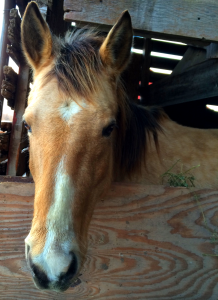 I haven’t had the best luck with my horses this winter. I went out Monday morning (a week ago) to feed, and saw Penny standing out by the hay feeder alone. All the other horses were inside their run-in shed, as it was a cold morning with high winds and blowing snow. I didn’t think too much about it, until I got out of the pickup and heard her whinny. I thought to myself, “I have never heard Penny whinny before.”
I haven’t had the best luck with my horses this winter. I went out Monday morning (a week ago) to feed, and saw Penny standing out by the hay feeder alone. All the other horses were inside their run-in shed, as it was a cold morning with high winds and blowing snow. I didn’t think too much about it, until I got out of the pickup and heard her whinny. I thought to myself, “I have never heard Penny whinny before.”
So I ran out there to find her laying in the snow (she had been standing only a moment before) and when I approached she got to her feet without putting any weight on her right hind. I could see she had a cut, but couldn’t tell how bad it was. Then I looked around the pen, trying to see what she had cut herself on, and found puddles of blood in the snow. I do have barbed wire fences, but the bottom wire is high off the ground and we run a single electric strand on the inside of the top wire to keep them away from it. I didn’t see any loose wire or low-hanging strands that might indicate she had caught a hind foot over the fence and pulled back.
By this time, she was lying down again, flat out in the snow with her head on the ground. I had forgotten my cell phone at the house, so I ran back to the pickup to drive home and get it and call the vet. It hit me all of a sudden that she might have lost too much blood and could die before I got back to the farm. I cried all the way home, silently berating myself for even having horses if this is what happens.
I called the vet, told my husband what had happened, and headed back out to the farm. The vet was on another farm call, and was over a half hour away, with no idea how long before he could come. I decided to try to get Penny into the stall so she wasn’t out there in the wind and snow.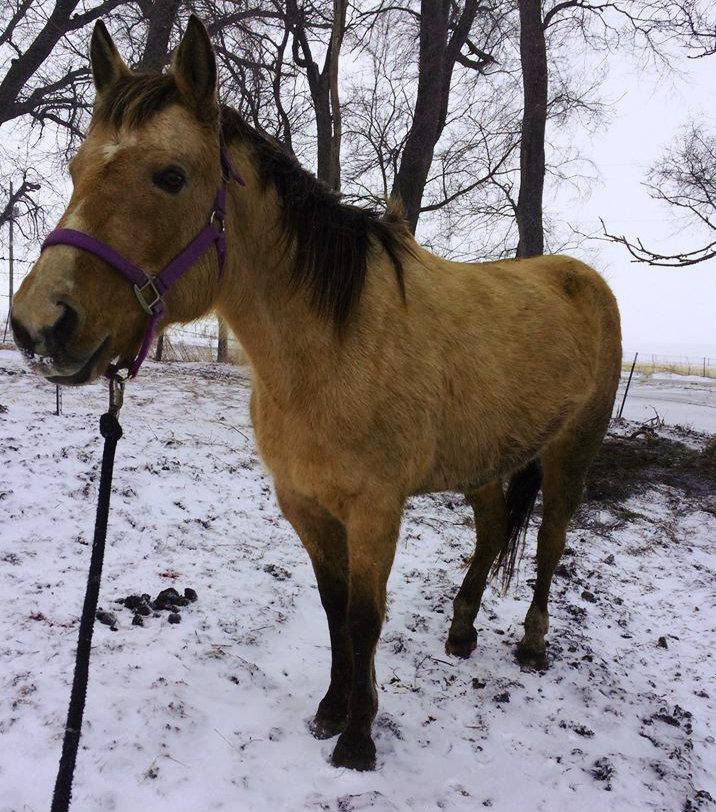
I got her haltered and led her about ten steps. She was hobbling, on icy footing, and not wanting to put any weight on that leg if she could help it. Then all of a sudden her injury started spurting blood in a steady stream and she just stood there as it pooled around her. I called my husband and he brought out a clean rag and duct tape and helped me pack the wound and wrap it tightly with the duct tape. I felt bad for moving her, since it made the wound bleed again, but the wind was so harsh and snow was falling, and I didn’t want her standing out in it.
Here’s what her hoof looked like when I found her: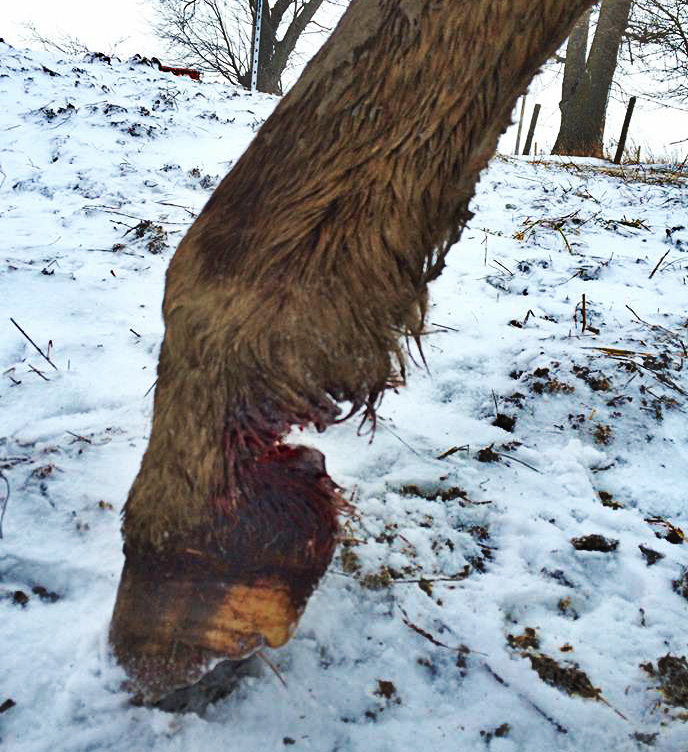
So we continued limping towards the stall. The office clerk from the veterinary’s office called and told me that she had talked to the vet and he would not be able to come until mid-afternoon, as he had two morning appointments. But she said if I trailered Penny there he could look at her at 11:30 in between appointments. So I decided to do that.
I wanted to take Red, as well, since he has had a bad cough all winter and has lost a lot of weight in spite of being on grain twice a day and free-choice hay from a big round bale. I had researched his symptoms on the internet and suspected he has heaves, as he is in his twenties, has a persistent cough, and his ribs and flank area visibly contract with every breath he takes, even while standing still. It might also help Penny to not fret, to have another horse in the trailer. So I got them loaded, and Penny climbed right into the trailer, walking a little easier now that her leg was wrapped.
At the vet, he came out to the trailer and looked at Penny. He said there is no possible way to stitch a horse’s pastern and not have it rip out, because it is such a flexing area the stitches won’t hold. So he said he would give her a tetanus booster, pack the wound with gauze pads and wrap it tightly, and gave me a little can of white powder antibiotics to mix in her feed daily for the next five days. He said this kind of wound takes much longer to heal than a chest wound or hip wound, because of the flexing. But he did not act like this would be fatal for Penny, for which I was thankful. He said keep it clean and wrap it for at least a couple of weeks, and if swelling got bad or moved higher up her leg, to call him.
Looking Red over, he confirmed my suspicion of him having heaves. He said it is like allergies in humans, and is treatable but not curable. He said having a big round bale is actually worse than being fed a little at a time, because the horse will stand there for eighteen hours a day with his nose stuck in that dusty hay bale. He said it’s better to pitch the hay to them, and then they can take a bite and raise their head up out of the hay while they chew it. He discussed three different types of treatments: a series of allergy shots, an antihistamine, or some kind of supplements to put in his feed. I told him we’d probably start some kind of treatment closer to spring, when we plan to be riding him.
So Penny is confined to her stall, which she hates. I don’t think she’s ever been stalled in her life. She is within sight of the other horses, and has food and water right there under her nose so she doesn’t even have to take a step to eat it. She can turn around and lie down, to take weight off her injured foot, and has it pretty easy since she isn’t being bossed around or chased by the more dominant horses. But she’s not very happy.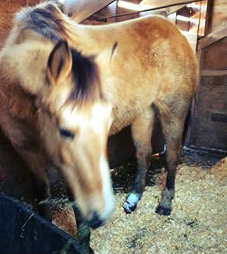
I did find out what she got cut on. Their run-in three-sided shed has a skirting of corrugated tin, and it is an old shed and a second door-way was cut on one side to allow entry from another pen. I noticed that the tin was pulled out away from the shed a little and when I looked closely, I saw drops of blood there on the side of the shed. So I curled the tin back under itself so that the sharp edge was not exposed and hammered it flat against the shed. It’s hard to believe something like that could cut a horse’s foot half 0ff, but that’s exactly what happened. I should have noticed and fixed it a long time ago.
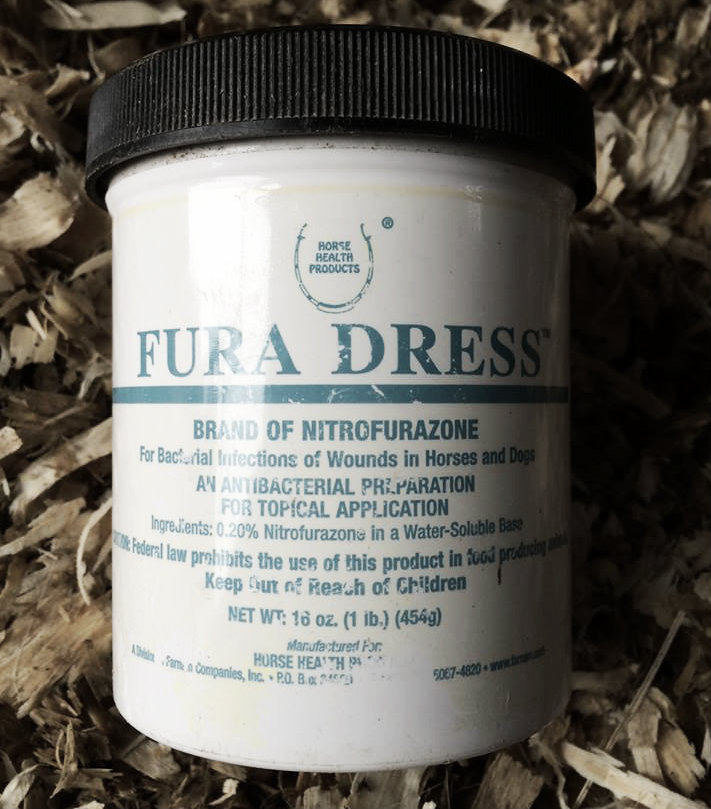 As for the wound, it is just above the hoof, at the back of the hind pastern, and it’s hard to say how deep it is. She does put a little weight on it from time to time, and it seems to feel better to her after I change the bandage and put a fresh wrap on it. I am using a nitrofurazone salve, put on the gauze pad, and placed to cover the wound, then wrapped snugly to cover the heel and up to the pastern. The nitrofurazone is antibacterial and also keeps the wound softened so it doesn’t get dry and crack. I have to soak the hoof in a bucket of water sometimes to get the old bandage off without pulling, but Penny is very patient about it and has never tried to kick or get away from me when I’m working on it. It’s like she can sense I am trying to help her.
As for the wound, it is just above the hoof, at the back of the hind pastern, and it’s hard to say how deep it is. She does put a little weight on it from time to time, and it seems to feel better to her after I change the bandage and put a fresh wrap on it. I am using a nitrofurazone salve, put on the gauze pad, and placed to cover the wound, then wrapped snugly to cover the heel and up to the pastern. The nitrofurazone is antibacterial and also keeps the wound softened so it doesn’t get dry and crack. I have to soak the hoof in a bucket of water sometimes to get the old bandage off without pulling, but Penny is very patient about it and has never tried to kick or get away from me when I’m working on it. It’s like she can sense I am trying to help her.
Here’s a rather graphic photo of what the wound looks like when washed and cleaned: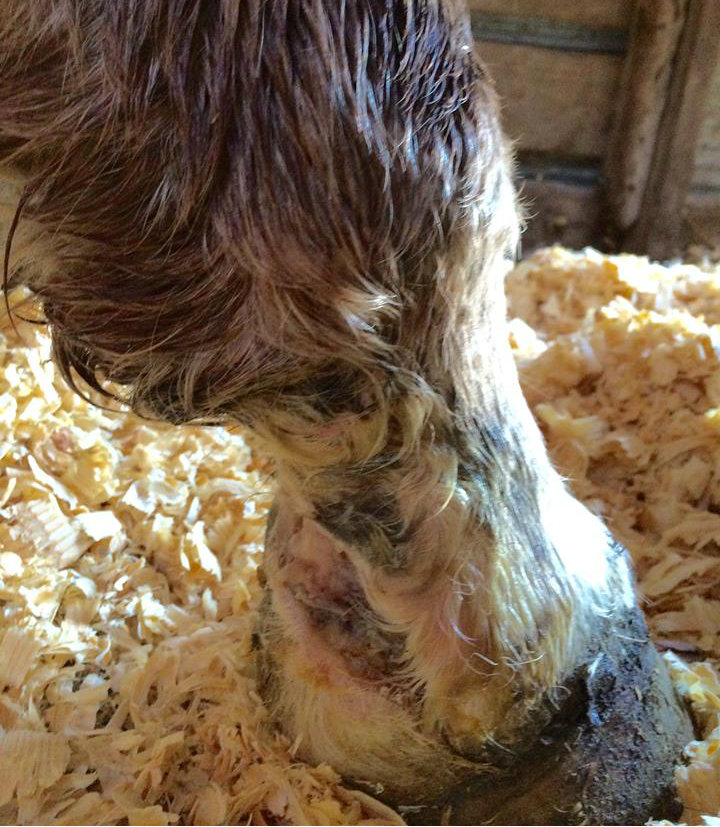
And here’s how it looks all bandaged up: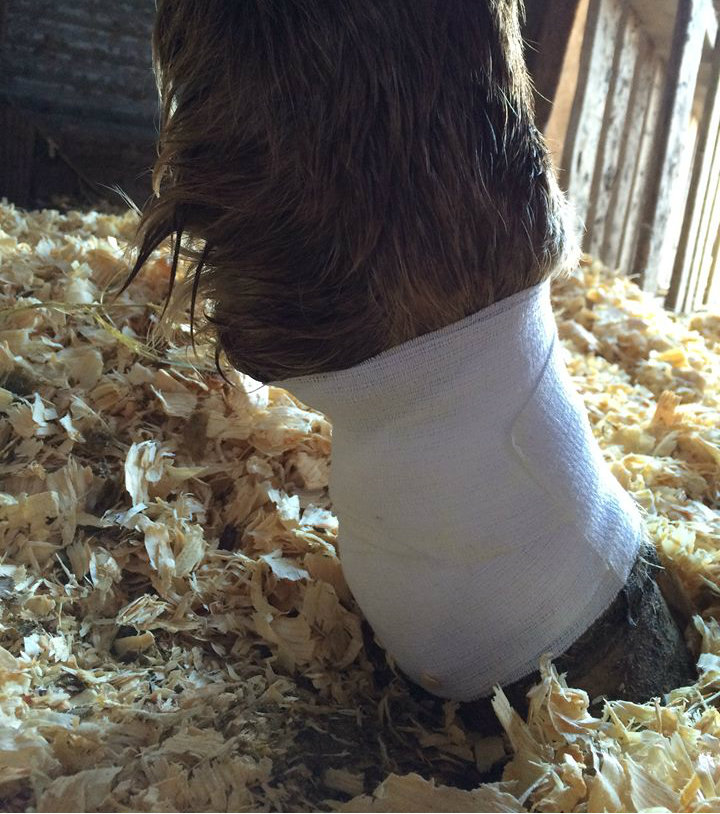
I’m not sure how long she will have to stay inside, but as muddy as it is right now, there’s no chance of her going out. Also, she is at the bottom of the pecking order, and I don’t want the others chasing her. So it may be months before she gets to go outside. I’m hoping we can keep it from getting infected, and hoping it heals so she is sound to ride again.
I haven’t ridden Penny in a long time, because she wouldn’t let me catch her and I just didn’t take the time to work with her enough to get her over it. Now that I am haltering her twice a day to tie her at the back of the stall while I clean the stall and treat her wound, she is getting used to being caught.
I am also learning that Penny is not like other horses. Most of the time, when I’m catching a horse, I keep the halter down by my side, get close with a neck rub or pat on the withers, slide my right arm under the horse’s neck and hold its head close while I pull out the halter and put it on. When I would try this with Penny, she hated to be held with my arm around her neck, and would pull away and run off and not let me catch her. I have learned that Penny prefers me to hold the halter out in front of her, and she will lower her head and put her nose in it, and then allow me to buckle it. That’s how she likes it to be. I think if I had tried that a long time ago, we would have gotten along much better. Silly mare.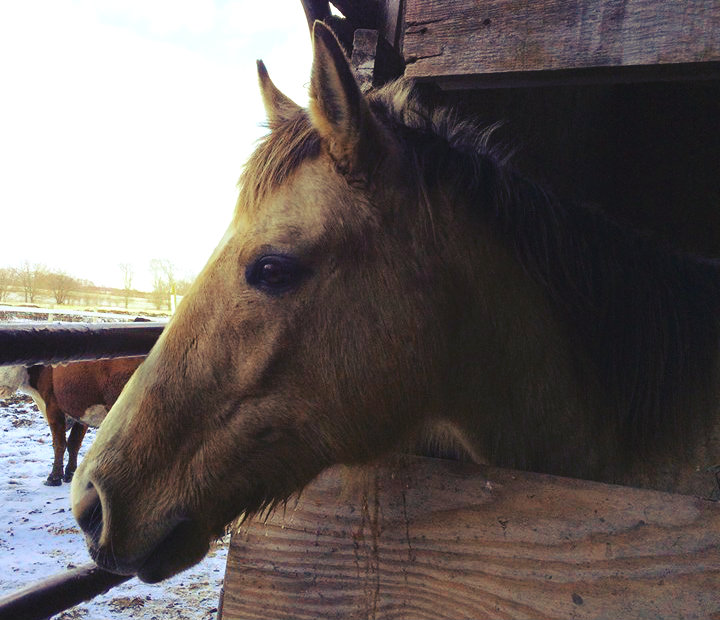
I just hope so much that she gets better and is able to walk normally when it is all healed.

